5 Thing (We’ll Bet) You Didn’t Know About…Bloomsbury
Home to the magnificent British Museum, Bloomsbury is also a literary lover’s delight teeming with history and brimming with beautiful architecture; next time you’re there, impress your friends with these brilliant stories (just don’t tell them you got your information from us!)
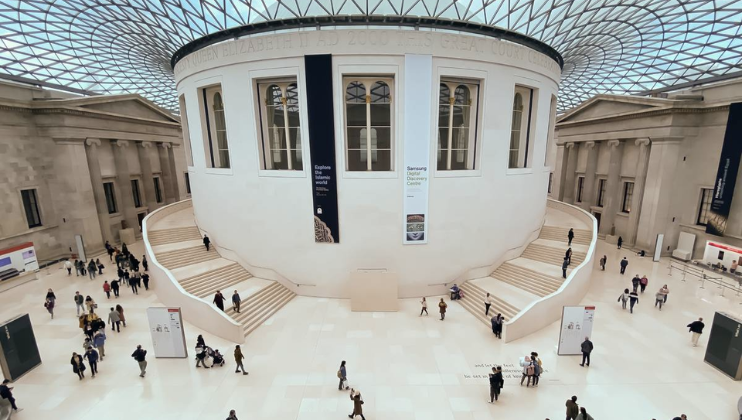
The Foundlings of Bloomsbury
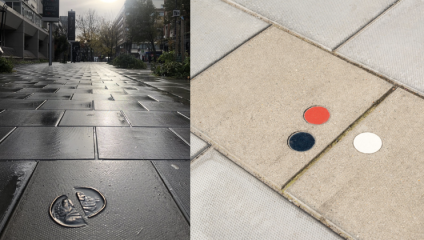
Marchmont Street, Bloomsbury, London
An art installation on the pavement of Marchmont Street pays tribute to The Foundling Hospital, which was a central part of Bloomsbury; in the 18th Century it was quite common for poor and destitute mothers to abandon their children, so the Hospital (run by retired sea captain Sir Thomas Coram) opened its doors 1741 to take care of as many of these children as it could.
The fate of each child would be decided by a lucky draw involving three balls in a bag; if a white ball was picked, then the child (if healthy) would be taken in, raised and trained to become a servant or a sailor. If a red ball was picked then that child would have to hope that they could take the place of one who failed the medical examinations. If a black ball was picked, the child would be turned away.
Dotted all the way along the street you’ll find examples of the ‘tokens’ that many mothers would leave with their child in the hope that they might later identify them by the token because after so long, mother and child would not recognise one another. This was the inspiration behind the locket given to Oliver Twist in Charles Dickens’ classic novel.
Today the Foundling Hospital continues as the childrens’ charity Coram, and you can visit The Foundling Museum to find out more about the Hospital and the history of the area, (open 10am - 5pm).
Snobbery in The Lamb
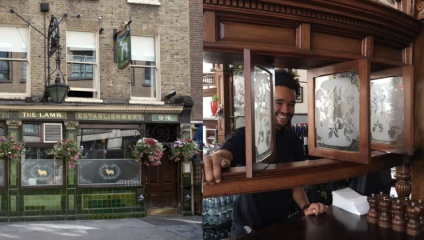
Lamb’s Conduit Street, Bloomsbury, London
Speaking of Charles Dickens, you can even visit his old boozer! (for more on Charlie Boy, visit The Charles Dickens Museum, just around the corner at 48 Doughty Street)
The Lamb, on the charming Lamb’s Conduit Street, is London’s third oldest pub (dating back to the 1720s) and the only pub in London to still have its ‘Snob Screens’; back in the day the high-class patrons evidently could not bear to look at the low-class bar staff for a SECOND longer than they absolutely had to.
These screnes, which each rotate on a swivel, would keep them from view and when one wanted a drink one would turn their screen, give one’s order, and then turn it again to resume one’s conversation with one’s more civilized acqaintances - well, I never!
Is that James Bond?
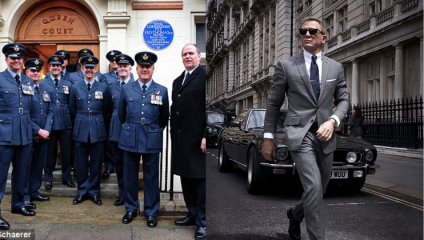
24-28 Queen Square, Bloomsbury, London WC1N 3BB
The name’s Yeo-Thomas - Forest Frederick Edward Yeo-Thomas (doesn’t have quite the same ring to it, does it?)
From Guildford Street, at the back of Great Ormond Street Hospital, you’ll see a blue plaque denoting the London home of the man who (it is believed) was the inspiration behind Ian Fleming’s James Bond; during the Second World War, Yeo-Thomas was the deputy head of the SOE - the Special Operations Executive, known unofficially as ‘Churchill’s private army‘ or ‘the ministry of ungentlemany warfare’.
When a covert mission in Paris went awry, our hero was captured by the Gestapo (who knew him as “The White Rabbit”). Although he was tortured, he gave no information of note away. After the war he went back to London (for two days) to convince Prime Minister Winston Churchill to back his plan to hunt down Nazis still in hiding - a personal vendetta mission codenamed “Operation Thug”. After the war he returned to his home in Paris, where he worked for a fashion house.
The Ministry of Ungentlemanly Warfare, directed by Guy Ritchie, is due for release in Spring 2024.
The Ministry of Truth in Russell Square
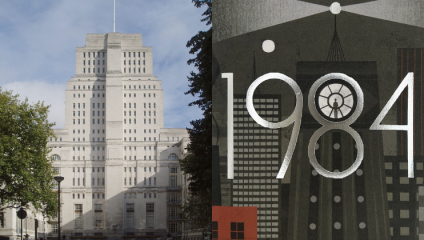
Senate House, Malet Street, Bloomsbury, London WC1E 7HU
The classic dystopian novel Nineteen-Eighty Four, by George Orwell, paints a picture of a world under mass-surveillance (which is where the term “Orwellian” comes from) and constantly at war. The protagonist Winston Smith works in the ironically name Ministry of Truth, which is really the site of the production of propaganda, editing historical records to reflect the government-approved version of events. On the outside walls of the building, which rises 300 metres into the air and contains over 3000 rooms, are the three slogans of the Party: "WAR IS PEACE," "FREEDOM IS SLAVERY," and "IGNORANCE IS STRENGTH."
If you’re sitting in Russell Square, enjoying the lush greenery, look to the West and you’ll see that Ministry of Truth - well, not really. Orwell took his inspiration for that fictional building from nearby Senate House, and it was actually used to represent the ministry in the 1984 film starring John Hurt.
The building is actually rather imperious; as the central library for the University of London, it needs to be big as it houses over 2 million books!
Get “Dolled-up” and hit the town!
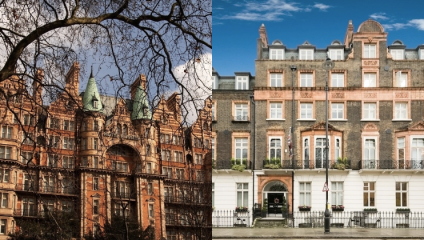
1-8 Russell Square, Bloomsbury, London, WC1B 5BE
On the opposite side of Russell Square stands the gorgeous, Grade-II landmark listed Kimpton-Fitzroy Hotel. Beautiful and lavish inside and out, the hotel was finished in 1898 with iconic teracotta facade, and an interior which represented the height of modernity, being the first building in London to have en-suite bathrooms!
The hotel was designed by architect Charles Fitzroy-Doll (who also designed the Titanic - but that’s another story!); its iconic teracotta facade was so popular that tenants in the nearby houses, including many of those in Russell Square itself, “Dolled-up” their window frames in the same teracotta - giving us the famous phrase.
Check out the Kimpton-Fitzroy (seriously, check it out!) here.